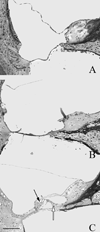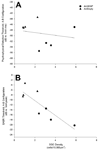Over-expression of BDNF by adenovirus with concurrent electrical stimulation improves cochlear implant thresholds and survival of auditory neurons
- PMID: 18768155
- PMCID: PMC2654221
- DOI: 10.1016/j.heares.2008.08.005
Over-expression of BDNF by adenovirus with concurrent electrical stimulation improves cochlear implant thresholds and survival of auditory neurons
Abstract
The survival of the auditory nerve in cases of sensorineural hearing loss is believed to be a major factor in effective cochlear implant function. The current study assesses two measures of cochlear implant thresholds following a post-deafening treatment intended to halt auditory nerve degeneration. We used an adenoviral construct containing a gene insert for brain-derived neurotrophic factor (BDNF), a construct that has previously been shown to promote neuronal survival in a number of biological systems. We implanted ototoxically deafened guinea pigs with a multichannel cochlear implant and delivered a single inoculation of an adenovirus suspension coding for BDNF (Ad.BDNF) into the scala tympani at the time of implantation. Thresholds to electrical stimulation were assessed both psychophysically and electrophysiologically over a period of 80 days. Spiral ganglion cell survival was analyzed at the 80 days time point. Compared to the control group, the Ad.BDNF treated group had lower psychophysical and electrophysiological thresholds as well as higher survival of spiral ganglion cells. Electrophysiological, but not psychophysical, thresholds correlated well with the density of spiral ganglion cells. These results indicate that the changes in the anatomy of the auditory nerve induced by the combination of Ad.BDNF inoculation and the electrical stimulation used for testing improved functional measures of CI performance.
Figures









References
-
- Altschuler RA, Cho Y, Ylikoski J, Pirvola U, Magal E, Miller JM. Rescue and regrowth of sensory nerves following deafferentation by neurotrophic factors. Ann N Y Acad Sci. 1999;884:305–311. - PubMed
-
- Bowers WJ, Chen X, Guo H, Frisina DR, Federoff HJ, Frisina RD. Neurotrophin-3 transduction attenuates cisplatin spiral ganglion neuron ototoxicity in the cochlea. Mol Ther. 2002;6:12–18. - PubMed
-
- Colombo J, Parkins CW. A model of electrical excitation of the mammalian auditory-nerve neuron. Hear Res. 1987;31:287–311. - PubMed
Publication types
MeSH terms
Substances
Grants and funding
LinkOut - more resources
Full Text Sources
Other Literature Sources
Medical

